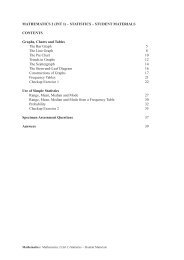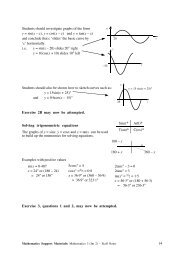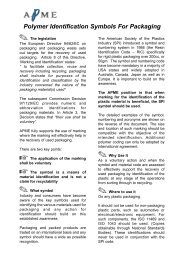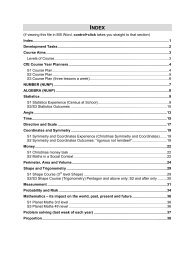Advanced Higher Maths: Formulae - Newbattle Community High ...
Advanced Higher Maths: Formulae - Newbattle Community High ...
Advanced Higher Maths: Formulae - Newbattle Community High ...
You also want an ePaper? Increase the reach of your titles
YUMPU automatically turns print PDFs into web optimized ePapers that Google loves.
<strong>Advanced</strong> <strong><strong>High</strong>er</strong> <strong>Maths</strong>: <strong>Formulae</strong><br />
<strong>Advanced</strong> <strong><strong>High</strong>er</strong> Mathematics<br />
Green (G): <strong>Formulae</strong> you absolutely must memorise in order to pass <strong>Advanced</strong><br />
<strong><strong>High</strong>er</strong> maths. Remember you get no formula sheet at all in the exam!<br />
Amber (A): You don’t have to memorise these formulae, as it is possible to derive<br />
them from scratch in the exam. But… it will save you a lot of time if you do choose<br />
to memorise them, and I advise that you do.<br />
Red (R): Don’t worry about memorising these. Just use this sheet to help jog your<br />
memory in classwork and homework. One or two of these formulae are on the<br />
syllabus, but are sufficiently obscure that I don’t think it essential to memorise them.<br />
Trigonometric Identities: (from Intermediate 2 and <strong><strong>High</strong>er</strong>)<br />
Links<br />
between<br />
ratios<br />
Essential <strong>Formulae</strong> to know<br />
off by heart for the exam (G)<br />
2 2<br />
cos Asin A 1<br />
Other useful ones that may<br />
be useful for<br />
homework/classwork etc.<br />
2 2<br />
1 tan A sec A (A)<br />
2 2<br />
cot A 1 cosec A (R)<br />
sin A<br />
tan A <br />
cos A<br />
Squared<br />
2 1<br />
cos x <br />
2<br />
(1 cos 2 x)<br />
2 1<br />
sin x <br />
2<br />
(1 cos 2 x)<br />
Compound sin( A B) sin Acos B<br />
cos Asin<br />
B<br />
tan A tan B<br />
tan( A B)<br />
(R)<br />
Angle cos( A B) cos Acos B<br />
sin Asin<br />
B<br />
1 tan A tanB<br />
Double sin(2 A) 2sin Acos<br />
A<br />
2tanA<br />
Angle (A) tan(2 A)<br />
(R)<br />
2 2<br />
2<br />
cos(2 A) cos Asin<br />
A<br />
1 tan A<br />
Exact Values(you should know all these, though there is no non-calculator paper, unlike <strong><strong>High</strong>er</strong>)<br />
0<br />
3<br />
<br />
6 4 3 2 2<br />
2<br />
sin 0<br />
1 1 3<br />
2 2 2<br />
1 0 1 0<br />
cos 1<br />
3 1 1<br />
2 2 2<br />
0 1 0 1<br />
tan 0<br />
1<br />
3<br />
1 3 undef. 0 undef. 0<br />
Unit 2.3: Complex Numbers<br />
For the complex number, z a bi,<br />
<br />
the modulus is given by<br />
2 2<br />
z a b<br />
<br />
b<br />
and the argument is given by tan <br />
a<br />
<br />
The conjugate is z a<br />
bi<br />
Negative facts:<br />
sin( <br />
) sin( )<br />
cos( <br />
) cos( )<br />
tan( <br />
) tan(<br />
)<br />
De Moivre’s Theorem says that<br />
for any z r(cos<br />
isin ) , then n n<br />
z r (cos n<br />
isin n<br />
) ( n )<br />
<strong>Newbattle</strong> <strong>Community</strong> <strong>High</strong> School © D Watkins 2014
<strong>Advanced</strong> <strong><strong>High</strong>er</strong> Mathematics<br />
Units 1.2 and 2.1: Differentiation<br />
f( x) f '( x)<br />
tan x<br />
sec<br />
sec x sec xtan<br />
x<br />
cosec x cosec xcot<br />
x<br />
cot x<br />
2<br />
cosec<br />
x<br />
ln f( x)<br />
f '( x)<br />
f( x)<br />
2<br />
x<br />
f ( x) f '( x)<br />
sin<br />
cos<br />
tan<br />
-1<br />
-1<br />
-1<br />
x<br />
x<br />
x<br />
1<br />
1<br />
x<br />
1<br />
2<br />
1<br />
x<br />
1<br />
2<br />
1<br />
x<br />
2<br />
To differentiate an inverse function:<br />
dx 1<br />
dy<br />
dy (A)<br />
dx<br />
Parametric Equations (where x f(), t y g()<br />
t ):<br />
Gradient (direction of movement) =<br />
dy dx<br />
Speed = <br />
<br />
2 2<br />
dt dt<br />
2<br />
d y x y<br />
y x<br />
<br />
2 3<br />
dx<br />
x<br />
Units 1.3 and 2.2: Integration<br />
dy<br />
dx <br />
dy<br />
dt<br />
dx<br />
dt<br />
(G) Essential Integrals to Learn<br />
f ( x) f ( x)<br />
dx<br />
sec<br />
2<br />
x tan x<br />
C<br />
tan x ln sec x C<br />
f '( x)<br />
f ( x)<br />
1<br />
2<br />
1 x<br />
1<br />
1 x<br />
2<br />
<br />
ln f ( x)<br />
C<br />
tan<br />
sin<br />
-1<br />
-1<br />
x C<br />
x C<br />
(A) Could use substitution if needed:<br />
f ( x) f ( xdx )<br />
1 1 x tan C<br />
<br />
1<br />
1<br />
x <br />
sin C<br />
2 2<br />
<br />
a x<br />
a<br />
<br />
1<br />
2 2<br />
<br />
a x a a<br />
<br />
(R) To save you time in hard questions for<br />
homework/classwork, no need to memorise:<br />
f ( x) f ( x)<br />
dx<br />
cosecx ln cosec xcot<br />
x C<br />
cot x ln sin x C<br />
sec x ln sec x<br />
tan x C<br />
<br />
Volume of solid of revolution f(x) between a and b:<br />
b<br />
2<br />
2<br />
About x axis: V f( x)<br />
dx About y axis: V <br />
f( y)<br />
dy<br />
Unit 1.4: Properties of functions<br />
a<br />
Odd function: f ( x) f( x)<br />
Even function: f ( x) f( x)<br />
(180° rotational symmetry) (line symmetry about the y-axis)<br />
<strong>Newbattle</strong> <strong>Community</strong> <strong>High</strong> School © D Watkins 2014<br />
b<br />
a
<strong>Advanced</strong> <strong><strong>High</strong>er</strong> Mathematics<br />
Unit 2.4: Sequences and Series<br />
Arithmetic Series Geometric Series<br />
u a( n1)<br />
d u ar<br />
n<br />
n<br />
1<br />
a(1 r )<br />
Sn<br />
<br />
2<br />
n(2 a( n1) d) Sn<br />
r 1<br />
1<br />
r<br />
a<br />
S<br />
<br />
r 1<br />
1<br />
r<br />
In particular, you are supposed to know that as a consequence of the last formula:<br />
1<br />
2 3<br />
1 r r r ...<br />
1 r <br />
1<br />
and also lim(1 ) n e (A)<br />
n<br />
n<br />
n<br />
n1<br />
Important Identities<br />
n<br />
n<br />
1<br />
k n ( n<br />
1)<br />
1 n<br />
k 1<br />
2<br />
k 1<br />
n<br />
2 1<br />
k n ( n 1)(2 n<br />
1) (note: this is named specifically on syllabus) (A)<br />
6<br />
k 1<br />
n<br />
n<br />
2<br />
3 <br />
1 2 2<br />
k <br />
k<br />
<br />
4<br />
n ( n1)<br />
k1 k1<br />
(also named specifically on syllabus) (A)<br />
<br />
<br />
Unit 3.3: Maclaurin Series<br />
( n)<br />
f(0) 2 f (0) n<br />
f( x) f(0) f(0) x ... x ... (G)<br />
2! n!<br />
and in particular:<br />
Very useful to memorise (A):<br />
2 3<br />
n<br />
x x x x<br />
e 1 x ... ...<br />
2! 3! n!<br />
3 5 7<br />
x x x<br />
sin x x ...<br />
3! 5! 7!<br />
2 4 6<br />
x x x<br />
cos x 1 ...<br />
2! 4! 6!<br />
On syllabus but less essential (R):<br />
3 5 7<br />
1<br />
x x x<br />
tan x x ...<br />
3 5 7<br />
2 3 4<br />
x x x<br />
ln(1 x) x ...<br />
2 3 4<br />
<strong>Newbattle</strong> <strong>Community</strong> <strong>High</strong> School © D Watkins 2014
<strong>Advanced</strong> <strong><strong>High</strong>er</strong> Mathematics<br />
Unit 1.1: Binomial Theorem<br />
The coefficient of the r th term in the binomial expansion ( x y) n is<br />
n<br />
C<br />
r<br />
n<br />
n!<br />
<br />
<br />
r r!( n<br />
r)!<br />
n<br />
x<br />
r<br />
<br />
nr<br />
y<br />
r<br />
Unit 3.1: Vectors, Lines and Planes<br />
Angle between two vectors: (<strong><strong>High</strong>er</strong>)<br />
ab a b cos<br />
Equations of a 3d line: through ( x1, y1, z<br />
1)<br />
and with direction vector d aibjck<br />
Parametric form<br />
Symmetric form<br />
x x1<br />
at<br />
x x1 y y1 z<br />
z<br />
y y1<br />
bt ( x atd )<br />
1<br />
( t)<br />
a b c<br />
z z ct<br />
1<br />
Equations of a plane:<br />
l <br />
Normal n is<br />
<br />
m<br />
n<br />
<br />
<br />
Point on line = P (with position vector a)<br />
Vector equation Symmetric/Cartesian Parametric (A)<br />
x•n<br />
a•n lx my nz k<br />
x abc<br />
where k a•n<br />
(b and c are any two nonparallel<br />
vectors in plane)<br />
Angle between two lines = Acute angle between their direction vectors<br />
Angle between two planes = Acute angle between their normals<br />
Angle between line and plane = 90° – (Acute angle between n and d)<br />
i j k<br />
Cross (vector) product: ab<br />
a1 a2 a3<br />
b b b<br />
1 2 3<br />
Scalar triple product:<br />
a a a<br />
1 2 3<br />
a ( bc)<br />
b b b (A)<br />
1 2 3<br />
c c c<br />
1 2 3<br />
(this is important but is only rated amber, as you wouldn’t have to remember it, as any<br />
exam question would have to tell you a<br />
( b<br />
c ))<br />
<strong>Newbattle</strong> <strong>Community</strong> <strong>High</strong> School © D Watkins 2014
<strong>Advanced</strong> <strong><strong>High</strong>er</strong> Mathematics<br />
Unit 3.2: Matrices<br />
2×2 matrices<br />
3×3 matrices<br />
a<br />
b<br />
A <br />
c<br />
d<br />
a b c<br />
<br />
A d e f<br />
g h i <br />
<br />
Determinant and Inverse<br />
1 1 d b<br />
det A ad bc and A <br />
ad bc c<br />
a <br />
e f d f d e<br />
det A a b c<br />
h i g i g h<br />
( AB)<br />
B A<br />
( AB) T B T A<br />
T<br />
det AB det Adet<br />
B<br />
1 1 1<br />
(A)<br />
Transformation Matrices<br />
cos<br />
sin<br />
<br />
Anti-CW Rotation by θ degrees <br />
<br />
sin<br />
cos<br />
, Reflection in y-axis 1 0<br />
<br />
0 1<br />
a<br />
0<br />
Enlargement by scale factor a <br />
0<br />
a , Reflection in x-axis 1 0 <br />
<br />
0 1<br />
Unit 3.4: Differential Equations (G)<br />
dy<br />
( )<br />
For Pxy ( ) Qx ( )<br />
dx , the Integrating Factor I(x) is<br />
and the solution is given by I( xy ) IxQxdx ( ) ( )<br />
e P x dx<br />
Second Order Differential Equations<br />
COMPLEMENTARY FUNCTION (Homogeneous Equations)<br />
Nature of roots<br />
Form of general solution<br />
Two distinct real m and n<br />
mx<br />
y Ae<br />
nx<br />
Be<br />
Real and equal m y ( A<br />
Bx) e<br />
mx<br />
Complex conjugate m p iq y e px ( Acosqx<br />
Bsin qx)<br />
PARTICULAR INTEGRAL (Inhomogeneous Equations)<br />
Right-hand side contains… For Particular Integral, try…<br />
sin ax or cos ax y Pcos ax<br />
Qsin<br />
ax<br />
e ax<br />
ax<br />
y Pe<br />
Linear expression y ax b<br />
y Px<br />
Q<br />
Quadratic expression<br />
2<br />
y ax bx<br />
c<br />
2<br />
y Px Qx<br />
R<br />
<strong>Newbattle</strong> <strong>Community</strong> <strong>High</strong> School © D Watkins 2014
















